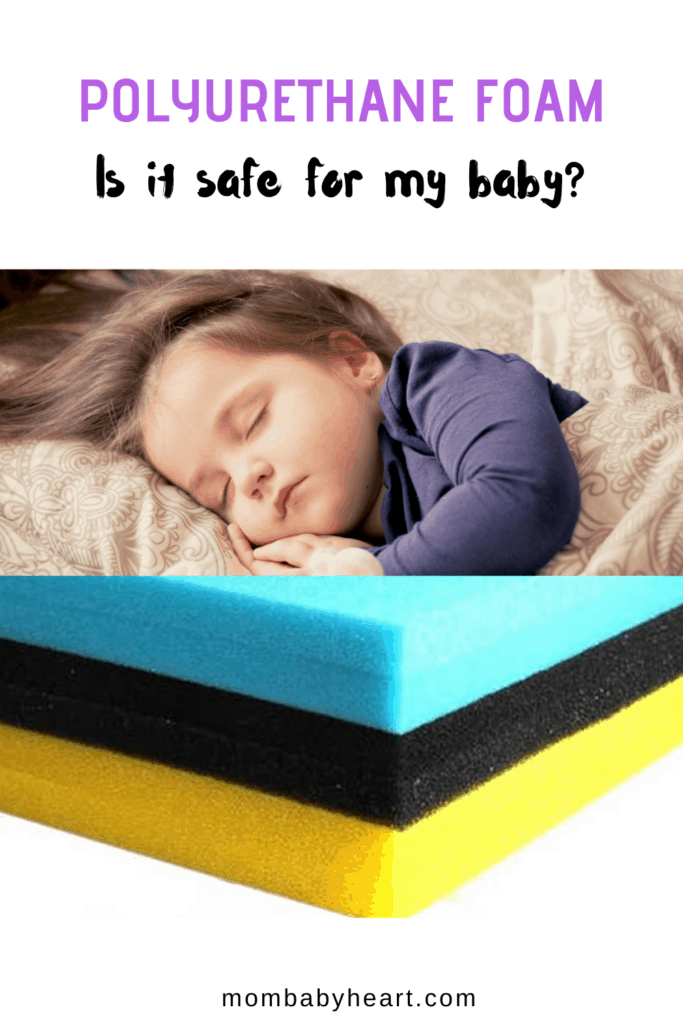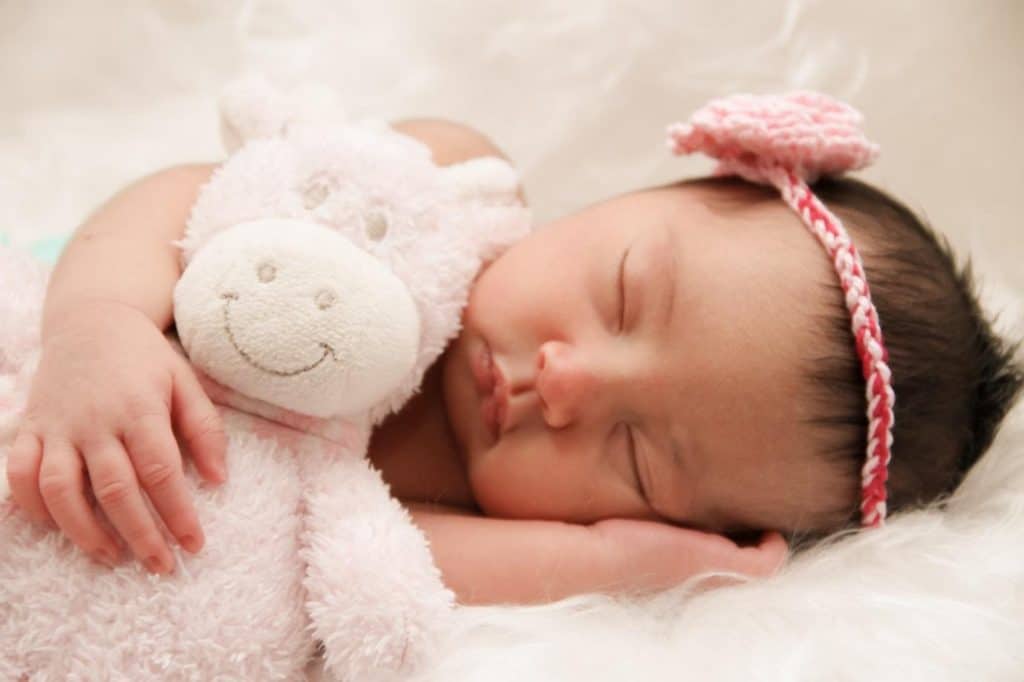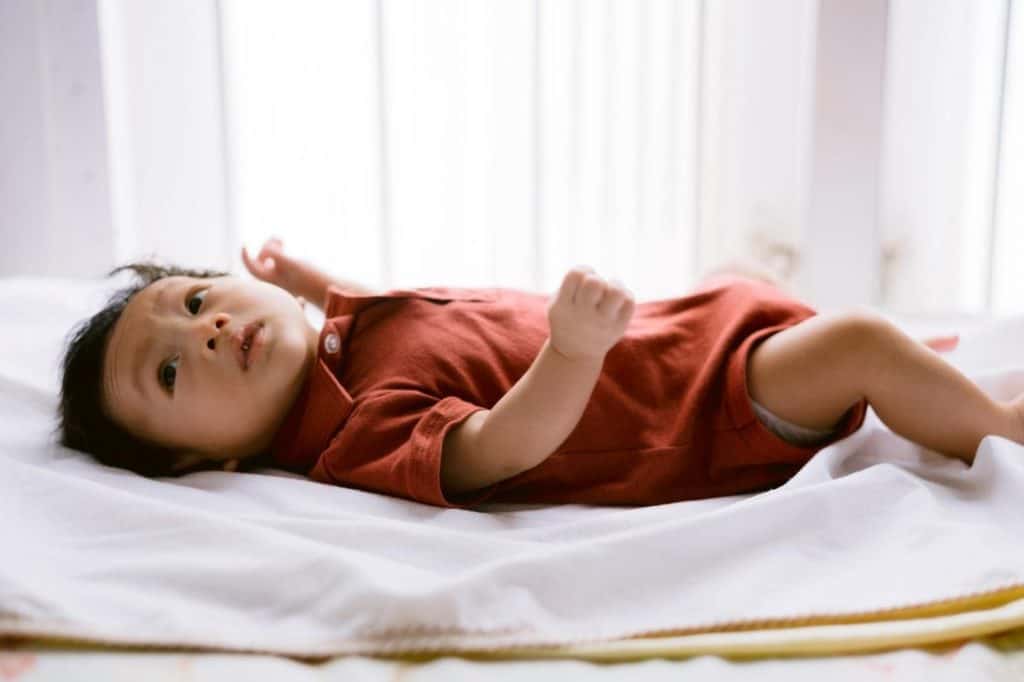Polyurethane foam has been the commonest mattresses for more than 70 years now, and anyone that has bought baby crib mattresses within this period likely got polyurethane foam.

Since these products have been in use for a long time, we mistake them to be safe and trust our babies on them, but this is not the case.
Research has proven that polyurethane foam releases volatile organic compounds. That means that our babies are exposed to these compounds and even get to breathe them in when they sleep.
*As an Amazon Associate I earn from qualifying purchases. This post may contain affiliate links from Amazon or other publishers I trust (at no extra cost to you). See disclosure for details.
This wasn’t so much of a threat until more research came up proving the same thing. Parents are beginning to wonder if these mattresses are safe for their babies.
I have chosen to shed more light on polyurethane foam, its chemistry, and its effect on your child’s body.
What is polyurethane foam?
Polyurethane foam is produced by reacting diisocyanates (toluene diisocyanate [TDI] and /or methylene diphenyl diisocyanate [MDI]) with a vast range of polyols.
They come from a family of plastics and are available in both the open cellular structure and solid form. The most frequently used baby foam is the open cellular structure, mostly known as flexible polyurethane foam.
This foam was invented in Germany by Dr. Otto Bayer in 1930. It was first developed for aircraft coating during World War II, but its commercial production began in 1954 after the war ended.
Polyurethane foam has become a significant part of our lives as it is found in almost every sector as mattresses, insulating panels, medical dressing, soundproofing, dishwashing sponges, etc.

How is polyurethane foam produced?
To produce polyurethane foam, diisocyanate, a derivative of crude oil, will be made to react with a polyol (complex alcohol). This reaction will result in a hot liquid sent through a pipe to a nozzle head.
This nozzle head will finely spray the hot liquid on a series of waxed papers being moved around by rollers.
As this hot liquid is being sprayed, carbon dioxide will also be streamed through another nozzle head. This reaction will cause the polyurethane to expand as it goes through the conveyor belt to form a foam strip.
After this, the foam will be trimmed and compressed into various shapes and sizes.
However, this foam will be rock solid because there are some gases trapped in it which must be released. For this to be done, the foam will be put under some heating lamps to dry.
During the drying process, the foam gases will start to bubble and burst out, leaving behind a porous and spongy substance called “polyurethane foam”.
Are polyurethane mattresses safe for use?
Immediately after the war, the invention of polyurethane foam seemed like a miracle for humanity. They provided comfort and made life easy. But after a while, better alternatives came up, and researchers got more interested in finding out more about polyurethane foam.

Many types of research proved the final products of polyurethane are full of chemicals, though they are declared inert in the manufacturers’ final products.
The challenge falls back to how this foam is produced and the types of gas they give off.
Like I mentioned before, polyurethane is made from some crude oil derivatives (diisocyanates) and complex alcohol (polyol). But the United States Environmental Protection Agency (USEPA) clearly states that isocyanates cause adverse health effects like lung damage, respiratory problems, asthma, skin damage, and eye irritation. But that is not all.
The diisocyanates TDI and MDI used for the production of this foam are found to be severe toxins and can be carcinogenic.
Catalysts like benzene and toluene are used to produce this foam and can cause blurry vision, sensitivity and irritation.
All these volatile organic compounds (VOCs) are released from the foam during its production in high amounts, and it continues long into the use of the foam. Have you ever wondered what causes that odor that hits you when you first remove the wrap from polyurethane foam?
However, these VOCs decrease after the foam has been used for a while.
Polyurethane foam has FLAME RETARDANTS CHEMICALS
Polyurethane foam is usually treated with flame retardant chemicals because diisocyanates, one of its key ingredients, are highly flammable.
This adds to the statement issued by the United States Environmental Protection Agency (USEPA), which states that daily, people in the United States are exposed to flame retardant chemicals. According to them, these chemicals are dangerous to both humans and animals and make it worse; they are volatile and not biodegradable.
However, some of them are independently certified by CertiPUR-US to ensure that they do not contain Tris(1, 3-dichloro-2-propyl) phosphate (TDCPP) and meet the standards for content emissions and durability. Some of these foam include Nook Pebble Air, Nook Pebble Lite, etc.
Nevertheless, I still recommend the use of more natural and eco-friendly alternatives like
How does this apply to you and your baby?
Though some brands of polyurethane foam are rated safe, we are still exposed to some that can be highly dangerous to you and your baby. And unless your head is buried down into research papers, you may not know that you just dragged a highly toxic mattress back home.

If the battle were to end with mattresses, it wouldn’t have been so much of a problem. But finding out that those flame retardants (the chemicals that make polyurethane foam extra toxic) are used in our car seats and even in our food in the supermarket make it a more significant concern.
So when we consume them, they show up in our urine, blood and even breast milk which makes it even scarier.
Here’s the highest need for caution
Adults can tolerate some of these chemicals to appreciable extents, but not babies. Babies are usually highly affected because their brains and bodies are still developing and their immune system is not even well mounted to prevent them from some of the crisis.
Now, babies spend 50 to 60% of their day sleeping, and if the baby crib mattress you bought is made from toxic polyurethane foam, your baby will be inhaling more than 10 times that amount of VOCs you take in as an adult.
Compared to their body weight, this amount of chemicals becomes too much for them to handle.
How do I then choose the best mattress for my baby?
The Duke University Foam Project has given us an even greater reason to be more observant when choosing our baby crib mattresses. In this project, more than 200 samples of beds were collected, and the result showed that more than 40 of them have flame retardants.
The research is still ongoing, and many more mattresses are still being checked.

When choosing a mini crib for your baby:
- Go for the organic counterpart
Organic mattresses are healthier for babies. They are made from natural materials and do not undergo many chemical processes and treatments. That means that there will be no much toxic for your baby to inhale.
These mattresses are usually labeled “organic”, but you should not just jump on everything with this label.
Some manufacturers just add a piece of organic content and claim that the whole is organic. Ask to be sure if it is 100% organic or 1%.
- Look out for Greenguard Gold certification
Greenguard Gold certification is a very important sign to look out for when choosing the safest mattress for your baby.
Mattresses with this certification have been screened and proven to be free from 10,000 dangerous chemicals and 360 volatile organic compounds.
These mattresses will have a low gas emission and are safe for your baby.
- Beware of the “117” seal.
When people say that a product should meet the technical bulletin 117, it sounds like a seal of approval, but not in all cases.
With baby mattresses, the 117 seal tells that the product contains some harmful flame retardant chemicals. Sadly, these seals can also be found in some organic mattresses, which is why you need to be very watchful.
- Non-vinyl Waterproof covers
You will find many recommendations for you to choose mattresses with waterproof covers. Though they are not entirely wrong, most of these waterproof covers contain VOCs and are harmful to health.

However, waterproof covers made from natural materials are safer. So, when choosing a waterproof cover for your baby’s bed, go for non-vinyl waterproof covers.
- Avoid used mattresses
Some new mattresses do give off an unpleasant odor, but that doesn’t make the used and older mattresses safer.
Used mattresses, especially those made on or before 2009, may be cost-effective, but they contain phthalate and other harmful chemicals.
Besides this, they could have moth and dust, which will affect your baby’s respiratory health. A few hundred dollars does not equal your baby’s safety on a mattress.
- Always air it before use
If you still want to go for polyurethane mattresses, remember to go for the ones certified by CertiPUR-US to ensure that they do not contain TDCPP.
These types of mattresses are best bought months before giving birth so that you can air them for a long time before your baby arrives. When the due time comes, the mattress must have given out most of its VOCs and become a bit safer for your baby.
If your baby sleeps on a polyurethane mattress,
You can reduce their risks of suffering the adverse effects of flame retardants by
- Frequently wash their hands and yours
- Using a wet mop or vacuum cleaner with a HEPA filter to clean the house
- Dusting your house with a damp cloth
- Keeping your child from chewing on flame retardant containing products
- Repairing every tear in your upholstered furniture and others that have foam

Can I use polyurethane pillows?
As long as the pillows are made from polyurethane foam, they still contain a high amount of VOCs and flame retardants; hence, they are still dangerous. However, you can choose polyurethane pillows that are accredited by CertPUR-US to be sure that the brand meets the standard for gas emission, content, and durability.
Nevertheless, it is always wiser to go for natural and more eco-friendly alternatives.
What are the replacements for polyurethane foam?
The best replacement for polyurethane foam is organic foam. I researched and came up with some foam from reputable manufacturers that are safe for your baby.
Through all the results, I found out that Naturepedic produces the best organic foam. Their mattresses exceed all the safety standards, it is Greenguard Gold certified and sticks to 100% natural components.
Here are some excellent specifications of Naturepedic mattresses and other non-toxic mattresses for your baby.

This mattress has been rated safe by Greenguard and the Global Organic Textile Standard. It is one of the lightest baby mattresses in the market.
The dual firmness makes it suitable for both babies and toddlers. The firmer side is for your baby, while the softer one will be useful when they become toddlers. In case you find it difficult to differentiate, you will find a label on both sides of the bed, telling which is which.
This mattress has no smell, even when new, and it comes with a silver lining that makes cleaning easy.
Parents particularly love this mattress though some cringe at the price. It costs $259 on amazon; meanwhile, there are cheaper and safe alternatives too.

Talking safety first, this crib is rated safe by Greenguard Gold and is CertiPUR-US certified, so you don’t need to worry about the VOCs.
It has a vinyl cover for easy cleaning. The size fits a standard crib perfectly, and according to parents, the mattress is noise-free.
It has dual firmness, with the firmer side being suitable for your infant and the other, the toddler. It looks like this mattress will last a lifetime as it comes with a 35-year warranty.
Parents on amazon highly recommend this mattress, especially for its noise-free attributes, saying that their baby gets to sleep on a white bed. You, too, can get this for $110 on amazon.

This mattress comes with a unique 100% cotton hypoallergenic bed cover that makes the mattress comfy for your baby.
It is certified by CertiPUR to be safe with low gas emission and tested by an independent laboratory.
The mattress comes with a flip side technology to suit your baby’s need for firmness and the toddler’s softer comfort.
This crib size mattress weighs 12.97 pounds and has dimensions 27.5 x 52 x 5.5 inches. Parents rated it high for its ease of cleaning.
It is available on Amazon at $95.

Still from the brand “Naturepedic”, this natural mattress is made with your baby’s comfort in mind. It is made free from flame retardants and other questionable chemicals like phthalate, PVCs, formaldehyde, polyfluorinated compounds, etc.
It is 97% breathable and allows 360° airflow that makes it very suitable for your baby to sleep comfortably even when they start turning their faces down.
Also, it comes with a breathable organic bed cover to keep the mattress clean. You just need to remove and wash it when it gets soiled.
This mattress weighs 6.34 pounds but has incredible strength. It has the dimensions 27.5 x 52 x 5.5 inches to snugly fit any standard miniature baby crib.
Unlike many mini crib mattresses, the Lullaby Earth mattress has reinforced edges to keep your baby’s arms and legs from entering in between the mattress and crib.
This crib is available on Amazon at $199.

This 6-pound mattress is an Eco foam orthopedic mattress infused in plant oils. It is Consumer Product Improvement Act (CPSIA) compliant and Greenguard Gold, and CertiPUR-US certified.
It has no flame retardants and passes every state and federal flammability requirement. Also, it comes with an easy to clean waterproof organic cotton bed cover. So when spills occur, pull out the best cover and thoroughly wash it out.
This mattress costs $203.59 on Amazon.
Some frequently asked questions about polyurethane foam
Is polyurethane foam waterproof
Polyurethane foam is not completely waterproof, though it can repel water to a certain extent.
Is there latex in polyurethane foam?
No. However, polyurethane foam can have the same properties as latex. Latex is a natural product obtained from the sap of rubber trees, but polyurethane is a synthetic product obtained from the reaction of diisocyanates and polyols.
Can polyurethane foam be recycled?
No, the chemical procedure for producing polyurethane is irreversible; hence the foam cannot be recycled.
Is polyurethane foam flammable?
Yes, polyurethane foam is highly flammable; that is why it is treated with flame retardant chemicals.

Conclusion
Polyurethane serves many purposes, but to us as mothers, we are more concerned about its safety as the mattress for our babies. Polyurethane foam does contain very toxic chemicals, and though some are certified by CertPUR-US to prove their safety standards, it is better we ensure our baby’s health with more natural counterparts.
If, for any reason, you still go for a polyurethane mattress, buy it early before delivery and air it out for some weeks before your baby arrives.
- 50 Wise Names That Mean Old - April 3, 2023
- 50+ Sweet Names That Mean Guardian Angel - April 3, 2023
- 120+ Best Albanian Baby Names - April 3, 2023
